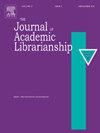“The library is my everything”: Mapping the meaning of university library spaces in Uganda
IF 2.3
3区 管理学
Q2 INFORMATION SCIENCE & LIBRARY SCIENCE
引用次数: 0
Abstract
The growing interconnectedness with the internet and the availability of digital materials threaten the historical importance of physical library spaces. This increase in Information Communication and Technologies (ICTs) and improved digital access to information may explain the decline in university library circulation figures. Consequently, many universities might consider physical libraries outdated and, in some cases, face closure if library management fails to demonstrate its value. Motivated by this argument, this ethnographic study explored how library users interact with physical environments in the digital age through a multi-site ethnographic research design. Data were gathered via observations (such as seating sweeps and participant observation), follow-up semi-structured individual interviews, and focus group discussions from four selected university libraries. The study found that users' perceptions of library spaces were shaped by their behaviour and experiences, and therefore, users' intentions were constructed through five lenses: personal, productive, social, knowledge hubs, “dead,” and through previous experiences. The study concludes that physical university libraries remain a popular ‘bedrock’ and a networked environment for academic purposes—addressing design challenges, spatial practices, and lived experiences. This research highlights that users' perceptions influence their usage patterns, preferences, and the meaning they assign, leading to an inefficient use of library resources, and builds upon studies that have regarded library spaces as both physical and symbolic.
“图书馆是我的一切”:描绘乌干达大学图书馆空间的意义
与互联网日益紧密的联系和数字材料的可用性威胁着实体图书馆空间的历史重要性。信息通信和技术(ict)的增加以及数字信息获取的改善可以解释大学图书馆发行量下降的原因。因此,许多大学可能认为实体图书馆已经过时,在某些情况下,如果图书馆管理不能证明其价值,就会面临关闭。在这一观点的推动下,本民族志研究通过多地点民族志研究设计,探讨了数字时代图书馆用户如何与物理环境互动。数据收集通过观察(如座位扫描和参与者观察),后续半结构化的个人访谈和焦点小组讨论从四个选定的大学图书馆。研究发现,用户对图书馆空间的感知是由他们的行为和经历塑造的,因此,用户的意图是通过五个镜头构建的:个人、生产、社交、知识中心、“死亡”和以前的经历。该研究的结论是,实体大学图书馆仍然是一个受欢迎的“基石”和学术目的的网络环境——解决设计挑战、空间实践和生活体验。这项研究强调了用户的感知影响他们的使用模式、偏好和他们赋予的意义,导致图书馆资源的低效利用,并建立在将图书馆空间视为物理和象征的研究基础上。
本文章由计算机程序翻译,如有差异,请以英文原文为准。
求助全文
约1分钟内获得全文
求助全文
来源期刊

Journal of Academic Librarianship
INFORMATION SCIENCE & LIBRARY SCIENCE-
CiteScore
5.30
自引率
15.40%
发文量
120
审稿时长
29 days
期刊介绍:
The Journal of Academic Librarianship, an international and refereed journal, publishes articles that focus on problems and issues germane to college and university libraries. JAL provides a forum for authors to present research findings and, where applicable, their practical applications and significance; analyze policies, practices, issues, and trends; speculate about the future of academic librarianship; present analytical bibliographic essays and philosophical treatises. JAL also brings to the attention of its readers information about hundreds of new and recently published books in library and information science, management, scholarly communication, and higher education. JAL, in addition, covers management and discipline-based software and information policy developments.
 求助内容:
求助内容: 应助结果提醒方式:
应助结果提醒方式:


